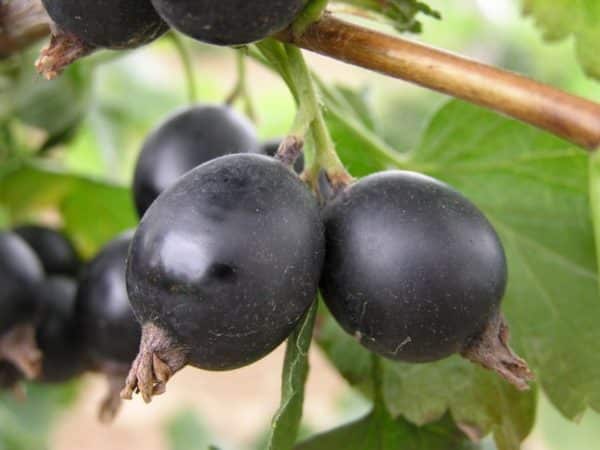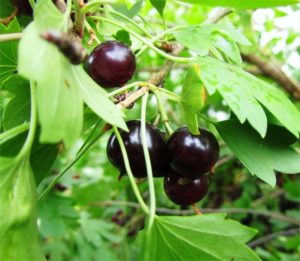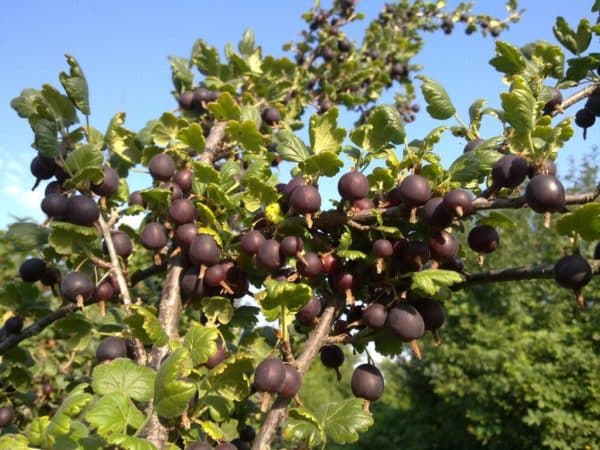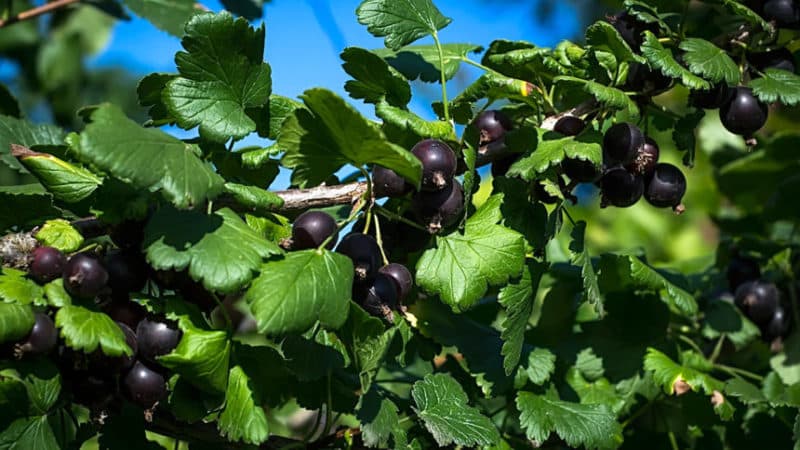What is good about a hybrid of gooseberries and currants and how to grow it
You won’t surprise anyone with gooseberry or blackcurrant bushes - they are in every Russian garden. But this unusual berry of purple color and pleasant taste is a curiosity. Not every gardener has heard of it. The plant differs from other berry bushes and at the same time has much in common with them. From the article you will learn what the hybrid of gooseberries and currants is called and what are the advantages of this crop.
What is yoshta
Yoshta is a hybrid of black currant and two types of gooseberries - ordinary and splayed. The perennial berry bush is widespread in the gardens of Western Europe.
In Russia, yoshta is rare, but every year more and more gardeners and summer residents learn about the berry.
Characteristics and description
The hybrid with an interesting name is distinguished by spreading bushes and a powerful and rapidly developing crown. The height of the shoots is more than 1.5 m, there are no thorns. One adult plant has about 20 shoots, the leaves are large and shiny, rich green. The plant is beautiful and lush, great for decorating a garden plot.
Yoshta flowers are bright and large, and the fruits are dark blue with a black tint, the weight of one berry is 3-5 g. Sometimes the fruits are red or bluish depending on the variety.
They grow in clusters of several pieces and resemble cherries in appearance. There is no aroma, the skin is dense and shiny. The taste is sweet and sour, balanced, the taste is pleasant, nutmeg.After ripening, the berries do not fall off and retain their taste and commercial qualities.

History of appearance
In the middle of the twentieth century. breeders around the world tried to create an improved version currant and gooseberry bushes - breed a plant without thorns, with immunity to diseases and pests, with large and tasty fruits.
Only German specialists succeeded in this in the 1980s. In Russia, the hybrid was cultivated in 1986 and is used in medicine, cooking, and cosmetology.
Advantages and disadvantages

The advantages of yoshta include the absence of thorns and thorns - this makes it easier to care for the plant and harvest, and there are no scratches or abrasions on your hands. Another plus of yoshta is its large and juicy berries with smooth skin.
They are used fresh or for freezing; juices, jams, compotes, jellies, and confitures are prepared. The pulp is healthy, contains vitamins C, P and anthocyanins. Eating berries stimulates metabolic processes and normalizes digestion.
Yoshta is frost-resistant, so it can be safely grown in regions with low temperatures. Agricultural technology is in many ways similar to caring for other berry bushes, but there are some nuances. Yoshta bears fruit already in the second year after planting, unlike currants, which produce the first harvest only after 3-4 years.
The disadvantage of the berry is the average yield. The hybrid is also demanding when it comes to feeding. Gardeners regularly fertilize berries with organic matter and complex preparations, since with a deficiency of microelements, the fruits become smaller and the plant gets sick more often.
The best hybrid varieties

The yield of yoshta also depends on the choice of variety. Domestic gardeners distinguish Moro, Krona, Yohini or Rext.
They are suitable for growing in the Russian climate and show stable yields:
- Moro — the height of the berry bush reaches 2.5 m, the crown is lush and spreading. The berries are large with a dense peel, black in color with a waxy coating. After ripening, they do not fall off and are used for fresh consumption and processing.
- Crown - Swiss variety, plant height up to 1.5 m. Medium-sized berries, pleasant taste, universal purpose. During the summer, about 3 kg are collected from the bush.
- Yohini - the variety is unpretentious in cultivation and has strong immunity to diseases. The flowers are large, the berries are without aroma, after maturation do not crumble. The taste is dessert, sweet.
- Rext — the height of the bush is about 2 m, the shoots are strong and erect. The fruits are very large, weighing 5 g per fruit. Rext does not require special rules for planting and care; it is unpretentious. The pulp is moderately sweet, the aroma is weak.
- EMB - bushes 1.8 m, crown moderately lush. They bear fruit abundantly for 2 months, the berries are sweet, the weight of one is 5 g. The coating protects the fruits from insect pests, the berries remain fresh and juicy after ripening.
The yield of yoshta depends on the variety, age of the plant, and region of cultivation. For example, varieties Krona or Rext, with proper care, produce up to 10 kg of berries per summer. The average for other varieties is about 5 kg.
Optimal growing conditions
Yoshta is unpretentious and grows well in any type of soil. However, the best yield is shown precisely on nutritious and loose soils with a neutral pH level. The area must be well lit and ventilated, otherwise the berries will become smaller and grow insipid.
The presence of groundwater near the bush is acceptable, but undesirable. It is recommended to plant gooseberry or currant bushes with yoshta - it is believed that such proximity increases productivity.
Frost and drought resistance

Yoshta is frost-resistant, but for the winter it is still covered with spruce branches. Even if the shoots freeze, they quickly recover.
Also, before winter, the roots of the plant are sprinkled with organic matter - humus or compost. This mulch layer protects the hybrid not only from frost, but also from insect pests that like to feast on the roots of the plant.
Yoshta is less resistant to drought. She loves moisture; lack of water causes yellow leaves and underdeveloped berries.
It is recommended to ensure that the soil on the site is always slightly moist. To do this, gardeners water the plant not at the root, but in special holes. Irrigation by sprinkling is also useful for the hybrid - it improves not only the yield, but also the decorative qualities of the shrub.
How to grow yoshta on your own plot
To grow a rich harvest of yoshta, summer residents prepare a site for planting in advance, select a variety, and buy seedlings.
They are also thinking about ways to apply fertilizing and other care measures.
Variety selection
The choice of variety depends on the purpose of cultivation. For example, if yoshta is planted as a hedge or for zoning a garden plot, spreading, tall and lush varieties are chosen. This could be Yoshta Moro or Rext.
If the purpose of cultivation is making jam or freezing, it is recommended to plant varieties Krona or EMB. Pay attention to frost resistance, care requirements, yield and immunity to diseases.
Selection and preparation of a place for cultivation and planting material
For yoshta, prepare a planting hole measuring 60x60 cm. This is done 2-3 weeks before planting. In addition to garden soil, a mixture of humus (150 g) and superphosphate (20 g) is added to it to make the soil more nutritious and fertile.If there is leaf soil, then add it too - such a mixture will ensure strong immunity of the yoshta and productivity.
Attention! Before preparing the hole, the ground on the site is cleared of debris and plant debris, and dug up with a shovel. It is recommended to disinfect the soil with a solution of Bordeaux mixture to destroy pest larvae and dangerous microorganisms.
When choosing seedlings, first of all pay attention to the root system. It must be healthy and powerful; weathered or dried areas on the roots are unacceptable. The bark of a healthy seedling is green, without spots or marks. rotten.
If the seedling was bought in the fall, before planting, all dry leaves and damaged roots are removed from it and only then planted on the site. If the roots are chapped, they are placed in a jar of water for a day.
Landing instructions
Yoshta is planted in spring or autumn. The distance between the bushes should be at least 2 m - the hybrid does not tolerate close proximity and crowding. The planting hole is filled 1/3 with soil and fertilizers, followed by 10 liters of water.
Further landing instructions:
- The bottom of the pit is slightly loosened.
- A seedling is placed in the center and the roots are straightened.
- Fill the hole with the top layer of garden soil, periodically gently shaking the seedling to avoid voids.
- Compact the soil around the seedling with your hands.
- Pour another 10 liters of water.
- Mulch with peat, straw, hay (layer thickness 10 cm).
- Trim the yoshta, leaving no more than 3 buds on each stem.
Further care and cultivation
Further care for yoshta consists of watering and fertilizers, treatment from diseases and trimmings. Moisturize the plant throughout the growing season; use rain, melt or soft tap water for irrigation..
The frequency and abundance of watering depends on the growing region and weather conditions. For example, in the south, shrubs are watered once a week, spending about 15 liters of water on an adult bush. If the summer is hot and rainy - once every 10 days, while the amount of moisture is reduced to 10 liters.
Fertilize the plant with organic matter and minerals. Twice a year, slurry is poured under the root - it saturates the yoshta with nitrogen and stimulates the development of the bush. During the break between organic fertilizers, mineral fertilizers are applied - water the yoshta with a urea solution (30 g of the substance per 10 liters of water) or pour double superphosphate or potassium salt under the root.
Attention! Before each watering or fertilizing, the soil is loosened. The procedure improves the absorption of nutrients and water, saturates the plant with oxygen. And after watering and fertilizing, the hybrid is sprinkled with mulch - it nourishes the soil and protects the roots from sunburn.
Despite the high immunity of yoshta to diseases and pests, gardeners annually carry out preventive measures. In the spring, before the buds open, it is sprayed with a solution of Nitrafen (1%).
The treatment is carried out at a temperature not lower than +5°C. In summer, the bush is sprayed with a solution of Bordeaux mixture or the drug "Oxyx". This is done no earlier than 2 weeks before harvest.
Pollinators of Yoshta
To increase productivity, yoshta is planted next to the parent plants - gooseberries or black currants. The best pollinating varieties among gooseberry varieties are Date, Ural Emerald, Northern Captain; among black currants - Dobrynya, Dachnitsa, Selechenskaya 2.
When planting, gardeners maintain an interval between plants of at least 2 m. For one yoshta bush there should be 2-3 blackcurrant and gooseberry bushes.This proximity guarantees 8-10 kg of berries per bush and lush flowering.
When the harvest ripens, how to harvest and use it

In central Russia, yoshta ripens at the end of July or beginning of August, in the south - at the beginning of July. The fruiting period lasts 3 weeks, so the harvest is harvested in several passes. Yoshta is collected in dry and windless weather, the berries are placed in a clean, shallow container. After they are sorted, damaged, dry or rotten fruits are thrown away. Yoshta is stored at room temperature for no more than 3 days - after this period, the berries lose their benefits and taste.
For longer storage, yoshta is frozen or dried. To do this, first wash it and leave it on a dry towel for 2 hours. To freeze, place in sealed bags and put in the freezer; for drying, place on a baking sheet and put in the oven or use an electric berry dryer.
Attention! Spicy sauces for meat, jam for the winter, confitures for ice cream and milk porridges are prepared from yoshta. In addition, drinks are made from the fruits: compotes, juices, jelly, cocktails.
Hybrid propagation
Common methods of propagating yoshta are by cuttings or layering. The first option is relevant for planting in spring. Young shoots are bent to the ground and pinched, sprinkled with soil in several places and watered abundantly with water. After 2 months they will take root, at which time they are separated from the main bush. Within a year, such a seedling will produce its first harvest.
Propagation by cuttings begins in winter - shoots 20 cm long are cut from the mother bush and placed in a room for 10 hours. It is important that the branches are taken from a healthy and fruit-bearing bush. They are rooted using water or the growth stimulator “Kornevin”.Afterwards, wrap it in a plastic bag and put it in a cool place (cellar, basement). In spring, seedlings are planted on the site.
Advice from experienced gardeners

Every year more and more gardeners plant yoshta bushes on their plots.
To ensure that the plant bears fruit abundantly, follow the recommendations of experienced summer residents:
- in the southern region, the plant is planted in the fall, not in the spring, so that the shrub produces its first harvest the following year;
- In the spring, nitrogen-containing fertilizers are applied, in the summer - potassium-phosphorus fertilizers (potassium magnesium, superphosphate);
- residues from healthy vegetable and flower crops are used as organic matter;
- Every year, dry branches are shortened and diseased and dry leaves are removed;
- The fruits are harvested within 5-10 days after ripening.
Conclusion
Yoshta is the result of crossing black currant and gooseberry. The weight of the berry reaches 5 g, the shape is rounded-oblong, the color is dark blue with red or purple hues.
Unlike the prickly gooseberry, yoshta has no thorns. The shoots are straight and spreading, the average height of the hybrid is about 2 m. The taste is pleasant, sweet and sour, the aroma is moderate. Jams and compotes, sauces and jellies are prepared from a hybrid of currants and gooseberries. Yoshta is a frost-resistant crop, rarely gets sick, and is unpretentious in care.